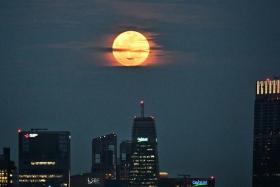Rare comet to light up Singapore’s night skies from Oct 11
Stargazers and astronomy enthusiasts can look to the skies to catch a rare comet from this weekend without using binoculars or telescopes.
Astronomical societies in Singapore say the Comet C/2023 A3 (Tsuchinshan–Atlas) – which has already been spotted in Singapore’s skies in the past few weeks during the hour before sunrise – will be most visible in the western part of the island from Oct 11 to 22, with minimal light pollution.
According to the Science Centre Observatory (SCOB) and NTU Astronomical Society, the comet is predicted to be at its brightest on Oct 11. However, SCOB said it will be hard to see the comet as it is expected to appear quite close to the Sun on Oct 11, and sunlight might drown out the light reflecting off the comet.
It added that the comet will most likely be visible between Oct 14 and 20 and that there is a strong possibility that observers can see the comet with the naked eye.
“Observers would have the best chance of seeing Comet C/2023 A3 on Oct 14, in the western skies just after sunset,” the SCOB said. However, the visibility of the comet is dependent on many factors such as the weather, sky conditions and the comet’s own behaviour, added the observatory.
Dr Koh Wee Ming, assistant honorary secretary of The Astronomical Society of Singapore (Tasos), said the best window for viewing the comet will likely be between Oct 13 and 22, as it will be visible directly in the west, following the setting sun.
NTU Astronomical Society said a good viewing time would be around 7.30pm, about 20 to 30 minutes after sunset.
Stargazers can observe the comet as it sets later than the sun in the west. As the distance between the comet and the Sun increases each day, it will remain visible in the sky for a longer period before setting, said Dr Koh. However, as the comet moves farther from Earth, it will become dimmer and harder to spot due to reduced sunlight reflecting off its surface and the increasing distance from Earth, he added.
To view the comet, observers should seek locations with unobstructed views of the western sky, with as little light pollution as possible, said SCOB, which will be hosting a virtual viewing session on Oct 17, from 7 to 8pm, if the weather permits.
The livestream from a telescope in the observatory will be aired on the Science Centre Singapore’s YouTube channel.
Dr Koh said that to catch a view of the comet, locations near bodies of water, such as reservoirs, where trees and buildings will not obstruct one’s line of sight, are recommended,
“Persistence is key – if you can’t see it one night, try again the next. Keep looking and don’t give up!” he added.
Comets are icy objects made of frozen gases, rocks, and dust that were left over when the solar system formed about 4.6 billion years ago. Their orbits around the Sun can take hundreds of thousands of years to complete.
They are known for their tails, which are produced by the release of gas and dust when the comet’s ice turns into gas and dust.
According to the NUS Astronomical Society, it is possible that Comet C/2023 A3 is orbiting around the Sun and has taken millions of years to come this close to Earth. If it is not orbiting the Sun and just passing through our solar system, it would never return.
The comet is particularly exciting to stargazers and astronomers around the world because of its upcoming peak brightness that is only rivalled by a few past comets, said NTU Astronomical Society.
Astrophotographer and member of Tasos, Mr Akash Anandh, said: “A naked-eye visible comet is extremely rare. There is no fixed frequency (of when you can see one), as comets appear randomly. There can be decades with no naked-eye visible comets, and there can be decades with more than one such bright comet.”
As they are made of dust and ice, many of them tend to disintegrate and disappear from view as they move closer to the Sun, added Mr Anandh.
Comets are traditionally named by or after the person or observatory that discovered them.
In this case, “Tsuchinshan-Atlas” refers to the two observatories that discovered the comet, namely Purple Mountain Observatory – or Tsuchinshan – in China on Jan 9, 2023 and Asteroid Terrestrial-impact Last Alert System (Atlas) in Africa on Feb 22 2023.
The alphabet “C” in C/2023 A3 refers to comets that take more than 200 years to finish an orbit around the Sun, or those that have passed through our solar system once. “2023” represents the year that the comet was discovered.
The comet was found on Jan 9, hence the “A” in the name, which refers to the first half of the month (B is second half), while the number “3” means that the comet is the third object discovered in the first half of January 2023.
Get The New Paper on your phone with the free TNP app. Download from the Apple App Store or Google Play Store now


